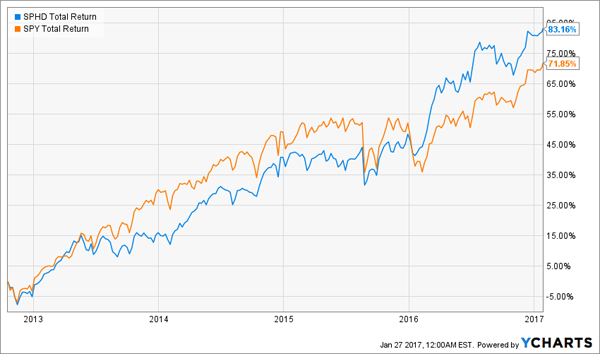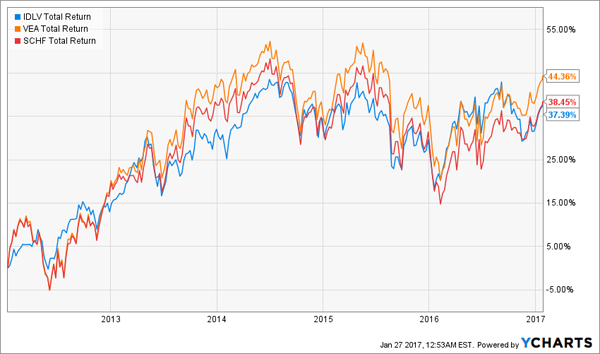Analysts are divided by whether they think this hard-charging bull market can last through the rest of 2017, but most market watchers agree on one thing: It’s going to be a bumpy ride no matter what. That’s why today, I’m going to show you a trio of funds that are designed to fend off volatility … and deliver high income to boot!
Within just a few days, President Donald Trump has signed a slew of executive orders and presidential memoranda with wide-reaching missions – withdrawing from the Trans Pacific Partnership, freezing federal workforce hiring and, of course, starting to roll the “border wall” rock down the hill. In the meanwhile, he has continued his string of market-moving tweets, and begun meetings with the likes of Detroit automakers Ford (F), General Motors (GM) and Fiat Chrysler (FCAU).
Trump’s fast and furious pen already has Wall Street adjusting and readjusting, trying to figure out how the market will move next. But the truth is: No one knows.
That’s why right now, low-volatility exchange-traded funds (ETFs) look more attractive than ever. These funds are part of the “smart beta” chorus, taking a major index, then slicing and dicing it to come up with a portfolio of its lowest-volatility members.
But what’s the point of safety if it doesn’t return anything? At that rate, you might as well duck into low-yielding short-term bonds. That’s why many investors prefer the protection and income of high-yielding low-volatility ETFs … like the three funds I want to highlight today:
PowerShares S&P 500 High Dividend Low Volatility Portfolio (SPHD)
Dividend Yield: 3.8%
Expenses: 0.30%
Right now, Invesco’s (IVZ) PowerShares division of ETFs is one of the market’s leaders in low-volatility products. That’s because PowerShares offers more than a dozen low-vol and low-beta strategies, including the popular PowerShares S&P 500 Low Volatility Portfolio ETF (SPLV).
However, those looking for a low-volatility product with some amplified income should instead focus on the PowerShares S&P 500 High Dividend Low Volatility Portfolio (SPHD), which is one of the best low-vol funds available.
SPHD’s 50-stock basket of stocks comes from a two-step screen. First, the index provider identifies the 75 highest-yielding securities in the S&P 500. Then, it selects the 50 stocks with the lowest 12-month volatility – and no sector can have more than 10 securities.
The result isn’t exactly what you’d expect.
For one, while the sector breakdown includes an 18% weight in stable, high-yielding utilities, SPHD also invests 15% of its funds in industrials, 13% in real estate and 11% in information technology.
Top holdings, too, aren’t your stereotypical defensive names. For instance, General Motors, CME Group (CME) and People’s United Financial (PBCT) are the current top holdings, at about 3% apiece.
SPHD yields just under 4% and boasts a beta of around 0.7. Still, despite that lean toward safety, the ETF has provided better total returns than the more growth-oriented S&P 500.
PowerShares’ SPHD Is a Market-Beating Low-Vol ETF

iShares Edge MSCI Min Vol EAFE ETF (EFAV)
Dividend Yield: 3.9%
Expenses: 0.20%
You don’t have to settle for volatility in international stock markets, either.
The iShares Edge MSCI Min Vol EAFE ETF (EFAV) is another low-vol strategy that’s based off a popular stock index – this time, the MSCI EAFE Index, which powers the iShares MSCI EAFE ETF (EFA), the largest developed-market fund on U.S. markets.
EFAV tracks an index of low-volatility stocks in developed markets in Europe, Asia and Australia, though more than half the fund is invested in just three countries – Japan (30%), United Kingdom (16%) and Switzerland (14%). The portfolio is much wider than SPHD, with the current roster including 227 holdings.
Here, financials are the top holding at just more than 16% of the fund, but traditional yield sectors like consumer staples (16%), telecom (10%) and utilities (8%) enjoy heavy weightings in EFAV; healthcare (16%) and industrials (14%) also help tamp down the volatility.
Top holdings are a who’s who of European blue chips, including the swiss trio of Nestle (NSRGY), Swiss Re (SSREY) and Roche Holding (RHHBY).
Like SPHD, EFAV – despite being focused less on growth, and more on yield and safety – has had a better go of things over the past five years, outperforming the EFA on a total return basis.
iShares’ EFAV: A Better Way to Buy Europe

PowerShares S&P International Developed Low Volatility Portfolio ETF (IDLV)
Dividend Yield: 3.8%
Expenses: 0.25%
Another way to invest internationally using the low-vol theme is the IDLV, which ventures into North America and the Middle East as well.
From a sector standpoint, more than a third of the fund is invested in just two sectors – financials (19%) and real estate (18%). Industrials (18%), consumer staples (14%) and utilities (12%) are among the other double-digit weightings.
Where IDLV really starts to differ from EFAV, though, is in geographical allocations. The fund’s top holding is actually Canadian stocks, which make up nearly a quarter of the fund. After that? Singapore and Australia, both of which make up about 11% each. Meanwhile, Hong Kong, the United Kingdom and Switzerland all have smaller allocations than they do in IDLV.
There aren’t many familiar faces in the top holdings, which include the likes of German commercial vehicle maker MAN SE, Canadian energy and services provider Emera Inc and Canadian telecom BCE Inc. (BCE). Still, these ho-hum names put up a pretty strong yield near the 4% mark, which is nice for a fund that’s less volatile than the broader markets.
Unfortunately, performance, while good, isn’t remarkable. IDLV over the past five years has trailed other international funds like Vanguard Emerging Markets ETF (VEA) and Schwab International Equity ETF (SCHF).
PowerShares’ IDLV Offers Nice Dividends, But …

Live Off Dividends Forever With This “Ultimate” Retirement Portfolio
If you want to retire comfortably, you need big dividends. The steady drumbeat of income is what helps pays the bills and keeps you afloat when you’ve stopped collecting a paycheck.
But if you want to get through retirement without ever touching your nest egg, you need more than just giant dividends – you need dividend growth to beat back inflation, and you need capital appreciation to keep building your nest egg. The “triple threat” stocks in my “8% No Withdrawal” retirement portfolio will deliver exactly that!
How many times have you seen a pundit shill for OK-yielding blue chips like Coca-Cola or Kellogg? They’re not bad companies, but they leave you with just 3% to 4% in dividends, paltry payout hikes and little in the way of growth potential.
You and I both know that math doesn’t add up. Those 3% to 4% returns on a nest egg of half a million dollars will only generate $20,000 in annual income from dividends at the high end!
You’ve worked your tail off for decades. So you deserve more out of your retirement.
My “No Withdrawal” portfolio ensures that you won’t have to settle during the most important years of your life. I’ve put together an all-star portfolio that allows you to collect an 8% yield, while growing your nest egg – an important aspect of retirement investing that most other strategies leave out.
I’ve spent most of the past few months digging into the high-dividend world, and I’ve had to weed out several yield traps that looked great on their surface, but potentially disastrous at a closer look. The result is an “ultimate” dividend portfolio that provides you with …
- No-doubt 6%, 7% even 8% yields – and in a couple of cases, double-digit dividends!
- The potential for 7% to 15% in annual capital gains
- Robust dividend growth that will keep up with (and beat) inflation
This all-star cluster of stocks features the very best of several high-income assets, from preferred stocks to REITs to closed-end funds and more, that combine for a yield of more than 8%.
This portfolio will let you live off dividend income alone without ever touching your nest egg. That means never having to worry about how you’ll pay your monthly bills, and never having to worry about wrecking your retirement account if disaster strikes.
Don’t scrape by on meager blue-chip returns and Social Security checks. You’ve worked too hard to settle when it matters most. Instead, invest intelligently and collect big, dependable dividend checks that will let you see the world and live in comfort for the rest of your post-career life.
Let me show you the path to the retirement you deserve. Click here and I’ll provide you with THREE special reports that show you how to build this “No Withdrawal” portfolio. You’ll get the names, tickers, buy prices and full analysis of their wealth-building potential – and it’s absolutely FREE!
